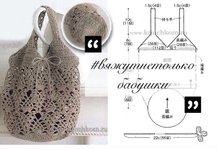
Asian spikelet is a fashionable trend of recent years, still impressive not only for fashionistas and beginners in knitting, but also for experienced needlewomen. Why does everyone like this type of large knitted braid? Primarily - texture, that is, volumes of a pattern that are unusual for knitwear that make many models of simple things so special.
One has only to see how knitted cardigans, sweaters, sweaters, hats or scarves decorated with an Asian spikelet look, and any admirer of knitting will definitely want to try to create such a thing with their own hands.


In addition, the Asian spikelet has its own knitting characteristics, so the end result looks so unusual and original. Let us consider in more detail the method of knitting this popular pattern and apply its patterns on different models of clothing.
Knitting pattern for Asian spikelet

The airiness and volumetricity of the Asian spikelet seem to be something beyond the limit at first glance. But there’s an insight into the essence of the knitting method of this pattern, it will become clear how this “magic” works: during knitting, loops are dialed in length rather than width of the product. This is due to the fact that the knitting of this pattern is performed on a vertical, and not a horizontal line. To make the knitting method understandable even to inexperienced knitters, consider a detailed description of the process of performing the Asian spikelet.
Workshop for beginners

This simple master class on knitting an Asian spikelet will help to understand the basics even for those who have little experience in working with knitting needles.
First you need to prepare yarn (one or more colors) and large knitting needles. It is better to use circular knitting needles for knitting an Asian spikelet.
Asian spikelet with knitting needles - knitting pattern and description:

For rapport, the number of loops that corresponds to the length of the main canvas of the future product is dialed in the set row. The number of loops should be a multiple of six (this includes edge loops).
- The first row consists of six front loops. Further work stops and knitting is turned over;
- The second row consists of six loops with purl knitting. Thus, knit only these 6 stitches, inclusive, up to the tenth row;
- In the eleventh, these six loops are knitted, plus three more facial ones. After that, knitting “Asian Spikelet” turns again;
- The twelfth row consists of six inside loops, then the knitting turns. After that, ten rows are knitted on these six loops.
According to the scheme, knit ten rows for every six loops. In this case, three of the knitted in advance and three more of the subsequent ones located on the spoke on the left side are taken. Continue this way until the end of the row. - The following are two more face and wrong side stitches.
- At the final stage, the action scheme is repeated, given that it is necessary to start knitting on the wrong side of the fabric using the wrong loops. This is done in order to change direction.

Video lesson
Here is how the process of knitting a classic Asian spikelet with characteristic holes in the canvas looks. Knitting such a pattern with knitting needles is not boring, since manipulations with turning the knitting need to be carried out regularly. Of course, at first it may seem that it is very difficult to work with such an unusual ornament. However, the result is worth these efforts - after all, a spikelet can become a highlight of your future thing.
Video: Asian spikelet knitting
Jacket popular pattern “Asian spikelet”

A classic-style blouse-cape looks very unusual thanks to the Asian spikelet pattern.
Knitting tools for cardigan "Asian spikelet":
- Cream-colored Monte yarn - seven skeins;
- Knitting needles number 5.
Knitting Techniques Used:
- Facial surface;
- Wrong surface.
Knitting pattern for sweaters with a popular Asian spikelet pattern and the progress of work:

- Dial 85 loops. Tie 14 rows, alternately knitting 2 rows of purl and 2 rows of front stitch.
- From the bottom edge of the fabric (hem), knit 60 loops with the front and rotate the work.
- Knit 12 rows of the first 4 loops, constantly turning the work.
- Then, also knit 12 rows from the next group of loops. Thus complete the series.
- From all 85 loops, knit 4 rows of front smoothness (yoke: knit from the top 25 loops. They should be knitted, alternately knitting 2 rows of the wrong and 2 rows of front stitch. To form a neckline in each 3rd row, do not knit the last 5 loops) .
- Knit, alternating the convex parts of the fabric with 4 rows of front surface (in the part of the yoke alternate 2 rows of the wrong side and 2 rows of the front surface).
- After completing 5 convex rows, set aside 44 loops. On the other knitting needle, dial 52 loops, connect with the remaining loops and continue knitting with convex motifs.
- Having connected 10 rows of convex motifs, close these 52 loops, return the deferred loops and continue knitting the back until 12 convex rows are formed.
- Set the loops again, add additional loops for the second sleeve and knit as described above.
- Having tied the sleeve, continue knitting the second front shelf. After the required number of convex rows, knit 14 rows, alternately knitting 2 rows of the front and 2 rows of the wrong side (to form a neckline in each 3rd row, do not tie the top 5 yoke loops). In the 10th row at the top of the yoke, make a hole for the button: knit the first 4 loops, make 1 crochet and reduce 1 loop. Knit the next 9 loops and make another 1 hole.
How to knit a fashionable cardigan?

Knitted cardigan with an Asian spikelet pattern - a real hit among fashionistas for several cool seasons in a row. Sometimes a cardigan made in this knitting technique is called "Chinchilla“, Since visually the pattern's pattern resembles the waves on the fur coats of these animals. The cardigan’s pattern is usually complemented by bright yarn of several colors, and especially beautiful is the gradient transition in several shades.
Such a bright and airy element of the wardrobe not only warms, but also lifts the mood, because it radically changes the appearance of its happy owner, adding to its image a touch of glamorous chic, not superfluous on cool gray days. In addition to the fact that the result is a beautiful thing, the knitting process also has its own charm. After all, this beauty will be connected by your hands! Beginning needlewomen do not need to doubt their abilities, remember: there is nothing impossible if there is a knitting scheme.
Knitting tools for cardigan "Asian spikelet":
- Thick bulk yarn 1.5 - 2 kg (Angora Real, Gold or Ram is suitable);
- Knitting needles No. 5.5 or 6 (preferably circular, but you can also straight).
Cardigan Pattern:
It is necessary to knit according to the pattern of the Asian spikelet (seeat the beginning of the article). The motive will consist of two “grains”: the first looks down, the second goes up. Between the grains, knit 4 rows of facial smoothness.
For small sizes, a spikelet 6/12 is recommended (6 loops in 12 rows), for medium sizes: 8/14, for large sizes - 8/16. For spikelets 8/14 (16), the set of loops is a multiple of 4, we pick up not 4, but 4 loops. We remove the first loop as an edge.
Pattern:

Knitting is vertical: from the collar through the carcass to the second collar. In total, 9 full spikelets for the carcass will need to be knitted, which can be knitted either as a whole fabric or in separate parts (after stitching they will not allow the product to stretch too far down). Also 2 spikelets for sleeves.
We knit a sample and calculate the number of loops for the set.
Average data: collar - 27 spikelets -112 loops (in our example - 28 - 122 loops)
shelf / back - 24 spikelets - 100 loops (25 - 104 loops)
armhole - 17 spikelets - 72 loops (18 - 76 loops)
sleeve - outer - 20 spikelets - 84 loops, inner - 14 spikelets - 60 loops.
The collar at the end is sewn in half. You can knit it separately from the carcass, then sew it, folding it in half.
Gradient:
For such a cardigan, the following set of loops is proposed: half the loops are typed in the lower color, the second half - the upper. A gradient of two shades of the same color looks good, then you can knit half (or slightly less / more) spikelets in one color, and the rest in another, without mixing the threads together.
The easiest way to knit a gradient is to make broaches inside out.
Without broaches, you can knit as follows: knit 14 rows of spikelet (8/14) and instead of the last 8 loops, knit only 4 of them, then put off any more unwanted thread and knit the remaining 4 loops with only two threads (3 additions possible).
Then add 4 more loops for the new spikelet, while grabbing the thread from the previous row (previously set aside). There are 3 threads in work again, and a transition has been made.
When all the spikelets are connected, it is possible to impose a “curved” middle of the spikelets of the shoulder line and the sleeve on the front surface.
Then it remains to sew the side and shoulder seams, sew the sleeve and the cardigan is ready.
Important: according to the sample, it is not always possible to correctly determine the number of loops (since under its own weight the web stretches down and it is difficult to calculate this stretching).
Step-by-step example of work progress:
For this example, it was required: 9 bobbin bobbin yarn (1600/100); knitting needles number 6.

Knitting of the spikelet from above begins, so we knit in the upper color (who has a gradient). Having reached the end - we knit 4 rows of front surface, then knitting goes from the bottom up (on the wrong side).


The finished carcass is very extended: from 62 cm to 90 cm. Therefore, the volume of the braids is lost, so you need to pull the spikelets with an additional thread. The carcass weight was 700 g.

After that, the shoulder seams are sewn together, the middle of the collar, the collar is sewn to the back. Then loops for sleeves are gathered and knit further according to calculations.


























